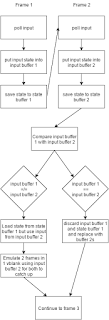The way rollback-based netplay (e.g., GGPO and RetroArch's current netplay implementation) works with emulators is that the two players exchange input states (which are small enough to pass back and forth within the time of a single frame of emulation) and then when they diverge, you roll back to a previous known-good time where the input still agreed and then emulate the intervening frames with the corrected input data to catch up (in RetroArch, these are called 'lag frames').
I had an idea for hiding a frame of latency that would work similar to that concept but in a single-player situation (click to embiggen):

The way it works is whenever the player's input changes, you roll back one frame and apply the new inputs retroactively and then emulate two frames to catch back up. This makes your inputs go into effect one frame before you actually pressed the button(s). This wouldn't result in a rollback loop because, even though we feel like we press a lot of buttons all the time when we play a game, most of the time (particularly from the emulator's point of view) we're really just holding a button or two.
You would want the audio to run one frame behind the video, so your audio buffer wouldn't be constantly emptying and skipping around every time you roll back. Instead, it would fill back up with the next frame's audio during catch-up. Despite running a frame behind the video, our brains would unconsciously sync the audio with the video, as they are very forgiving about that sort of thing (this is a known effect).
One drawback is that you would frequently lose a single frame of animation but thankfully our brains are quite good at papering over that sort of thing, as well. The other drawback to this method is that it would require emulating two full frames in the space of a single frame, so the CPU requirements for any emulator using it would be doubled.
Again, this method would hide a single frame of latency. While most PC setups have significantly more than one frame of latency to contend with, every little bit helps.
UPDATE (4/12/2016): I was talking to letoram, author of ArcanFE, the other day and he mentioned that he had implemented something just like this recently and that the lagging audio made everything seem *more* latent, presumably due to the everything-syncs-to-the-slowest effect mentioned in the above link. I didn't ask him whether muting/disabling audio helped with this or not.
UPDATE (4/30/2018): A few months ago, Dwedit--the author of PocketNES and Goomba Color emulators for GBA--mentioned having a similar idea and after some brief planning and discussion, he whipped up a working model and then refined it into a functional feature for RetroArch. It's included in the 1.7.2 release under the name "runahead". Some differences in his approach to the one I described include keeping audio in sync (rather than lagging behind) and having the option of running a second instance of the core to hop over to in the case of audio issues. To avoid weird rollback effects (see: the 'lose a single frame of animation' thing in my original post), Dwedit astutely recognized that as long as you keep the number of rollback frames below the number of internal lag frames in the game (that is, the number of frames it takes for your input to cause a reaction on the screen), the effect is completely invisible to the user.
3 comments:
Great idea, all for it!
I've thought about something like this before, but not for realtime purposes. for making tool-assisted speedruns on most games, you could see the result of your inputs immediately, instead of waiting the one or two extra frames. you could even set it up to show the outcome of each input permutation that you enter without ever manually advancing a frame. I think people today have been using memory watches and Lua scripts to peek at updated coordinates and such, but it's not the same kind of visual feedback.
This is an interesting concept that could potentially improve single-player gaming experiences.
Post a Comment